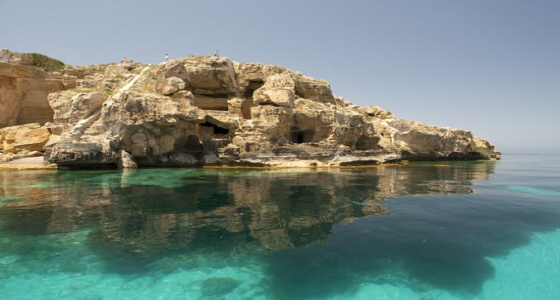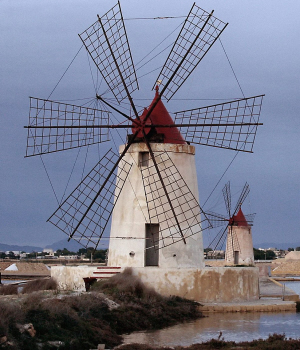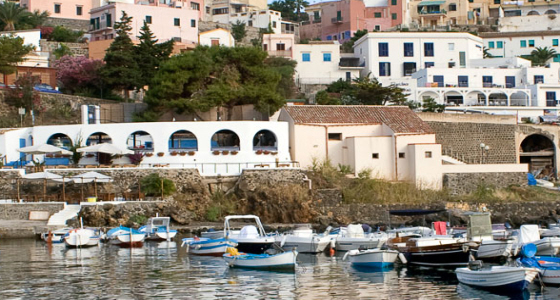
There are a number of islands around Sicily which offer great holiday getaways and great beaches. The Aeolians (or "Lipari Islands") and Malta (a sovereign nation but part of the Kingdom of Sicily under the Knights of Malta until 1797) are described on dedicated pages, while information on tiny Mozia will be found on the Marsala page.
 Favignana: Anciently called Aegusa (goats' island), Favignana is located just a few kilometers southwest of Trapani. It is the largest of the Egadi, or Egadian, Islands. Still known for their tuna (tunny) fishing, these islands are now popular as summer resorts. Favignana, in particular, is a favorite spot for Sicilian sun worshipers. The ferries from Trapani arrive at the port city of Favignana, from which transportation to the other islands (Levanzo, Marettimo) is available. The mattanza is a traditional annual event. While most of Favignana's beachgoers are Italian, and increasing number of foreign visitors now venture here each year. The best-known public beaches are Cala Rossa on Favignana and Cala Minnola on Levanzo.
Favignana: Anciently called Aegusa (goats' island), Favignana is located just a few kilometers southwest of Trapani. It is the largest of the Egadi, or Egadian, Islands. Still known for their tuna (tunny) fishing, these islands are now popular as summer resorts. Favignana, in particular, is a favorite spot for Sicilian sun worshipers. The ferries from Trapani arrive at the port city of Favignana, from which transportation to the other islands (Levanzo, Marettimo) is available. The mattanza is a traditional annual event. While most of Favignana's beachgoers are Italian, and increasing number of foreign visitors now venture here each year. The best-known public beaches are Cala Rossa on Favignana and Cala Minnola on Levanzo. Pantelleria: The ancient Cossyra lies in the Sicilian Channel 100 kilometers off the Sicilian coast and just 70 kilometers from Tunisia. In the past there was volcanic activity. The history of Pantelleria largely parallels that of Sicily, and there are ancient Phoenician walls on the island. The island was captured by the Allies in 1943 in action preceding the invasion of Sicily during the Second World War. It is so windy on Pantelleria that the olive trees grown here must be pruned in a squat manner; indeed the island's name derives from the Arabic phrase Bent al Rhia meaning "daughter of the wind." The island is known for its tasty capers. It has extensive vineyards and produces two fortified dessert wines, Moscato di Pantelleria and Passito di Pantelleria. Principal sights are the Specchio di Venere (Mirror of Venus), a lagoon in a volcanic crater, and the sesi, neolithic funeral mounds built of stone. There are many thermal springs; those in the Gadir and Monestero (in the Sauna Cave) are the best known. Cottages dot the island, and in summer the number of visitors far exceeds the native population of three thousand. There are ferries and hydrofoils from Trapani, and mopeds are a good way to get around the small island. Pantelleria's best public beach is Balata dei Turchi.
Lampedusa: Lampedusa, the largest of the Pelagian Islands, is the southernmost part of Italy. The other islands of the archipelago are Linnosa (known as Aethusa to the ancient Romans) and tiny Lampione (literally "big lamp" for its lighthouse). Larger than Pantelleria, Lampedusa lies in the Sicilian Channel 205 kilometers south of the Sicilian coast and only 113 kilometers from Tunisia - and 150 kilometers from Malta. There are around six thousand permanent residents. The island was a fief of the Tomasi family until the middle of the nineteenth century. On Lampedusa there are military facilities and a small prison, as well as facilities for refugees who frequently arrive by boat from Africa, but it is nevertheless an attractive holiday destination. It is reached by ferry service from Porto Empedocle outside Agrigento. There are regular flights, with more frequent service in summer. Lampedusa's best public beach is Spiaggia dei Conigli. Others are Cala Maluk, Cala Croce, Cala Galera and Cala Greca.

Ustica: Located about 50 kilometers north of Palermo, from which there is ferry service, this small volcanic island (having an area of only 8.6 square kilometers) is best known for its marine reserve and coastal caverns, though it boasts some Phoenician ruins and tombs.
Islets: Several of Sicily's smallest islands are famous in history or myth. The Cyclops Islets (or 'Islands of the Cyclops') along the Ionian coast north of Catania are chunks of the boulders hurled at Ulysses (Odysseus) by the dreaded Cyclops which lived atop Mount Etna. Isola delle Femmine (the 'women's island'), near the town of that name west of Palermo, was not, as is popularly believed, a place of exile for unfaithful wives, but it is now a refuge for migratory birds. Isola Bella, near Taormina, is no longer an island per se, but in centuries past, when water levels were generally higher than they are today, it was separated from land at high tide.
©2012 Best of Sicily (bestofsicily.com). Used by permission.
Many thanks





